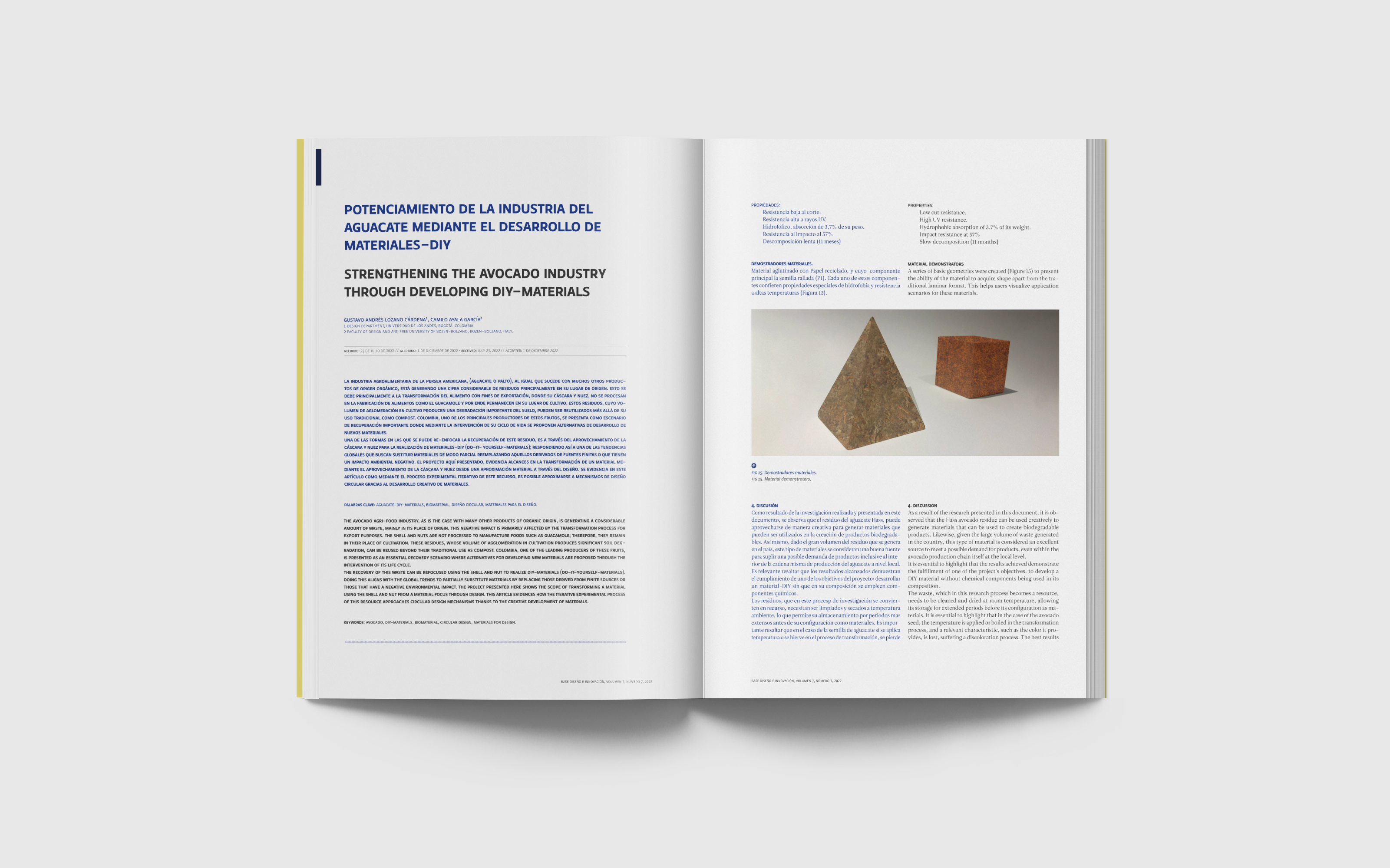Strengthening the avocado industry through developing DIY-materials
Main Article Content
Abstract
The avocado agri-food industry, as is the case with many other products of organic origin, is generating a considerable amount of waste, mainly in its place of origin. This negative impact is primarily affected by the transformation process for export purposes. The shell and nuts are not processed to manufacture foods such as guacamole; therefore, they remain in their place of cultivation. These residues, whose volume of agglomeration in cultivation produces significant soil degradation, can be reused beyond their traditional use as compost. Colombia, one of the leading producers of these fruits, is presented as an essential recovery scenario where alternatives for developing new materials are proposed through the intervention of its life cycle. The recovery of this waste can be refocused using the shell and nut to realize DIY-Materials (Do-It-Yourself-Materials). Doing this aligns with the global trends to partially substitute materials by replacing those derived from finite sources or those that have a negative environmental impact. The project presented here shows the scope of transforming a material using the shell and nut from a material focus through design. This article evidences how the iterative experimental process of this resource approaches circular design mechanisms thanks to the creative development of materials.
Article Details
References
Araki, K. (2018) Anima. https://www.kosuke-araki.com/anima
Ashby, M., & Johnson, K. (2014) Materials and design: The art and science of material selection in product design. Butterworth-Heinemann.
Aumer, S. K, (2014) Eggo. https://www.behance.net/gallery/25658555/EGGO-The-stool-out-of-egg-shell
Ayala-Garcia, C. (2019) The materials generation. The emerging experience of DIY-Materials. [Unpublished doctoral dissertation]. Politecnico di Milano. Retrieved from https://www.politesi.polimi.it/handle/10589/145194
Butterfield, H. M. (1963). A History of Subtropical Fruits and Nuts in California. University of California, Division of Agricultural Sciences.
Callister, C. & Rethwish, D. (2014) Materials science and engineering. An introduction. Wiley.
Cooper, R. G. (1990, May-June). Stage-Gate systems: a new tool for managing new products. Business Horizons, 33(3), 44-54. https://link.gale.com/apps/doc/A9114345/AONE?u=anon~a8bbe1fd&sid=googleScholar&xid=16569f8d
Crippa, M., Solazzo, E., Guizzardi, D., Monforti-Ferrario, F., Tubiello, F. N., & Leip, A. J. N. F. (2021). Food systems are responsible for a third of global anthropogenic GHG emissions. Nature Food, 2(3), 198-209. https://doi.org/10.1038/s43016-021-00225-9
Elleuch, B., Bouhamed, F., Elloussaief, M., & Jaghbir, M. (2018). Environmental sustainability and pollution prevention. Environmental Science and Pollution Research, 25(19), 18223-18225. https://doi.org/10.1007/s11356-017-0619-5
Feltwood (2016). ¿Puedes creer que esto era una lechuga? https://www.feltwood.es
Food and Agriculture Organization of the United Nations (2019). The State of Food and Agriculture 2019. Moving forward on food loss and waste reduction. https://www.fao.org/3/ca6030en/ca6030en.pdf
Fruit Leather Rotterdam (2015). Fruitleather Rotterdam. https://fruitleather.nl
Ge, M., Friedrich, J. & Vigna, L. (2020, February 6). Charts Explain Greenhouse Gas Emissions by Countries and Sectors. World Resources Institute. https://www.wri.org/data/world-greenhouse-gas-emissions-2019
Hijosa, C. (2015). Piñatex. https://www.ananas-anam.com/about-us/
IBM (2020). Environmentally friendly brand attributes that are important to consumers worldwide in 2020 [Graph]. https://www.statista.com/statistics/1234119/consumer-interest-in-sustainable-environmental-brands/#:~:text=Brand%20attributes%20that%20are%20important%20to%20consumers%20worldwide%202020&text=As%20of%202020%2C%2045%20percent,in%20brands%20that%20supported%20recycling.
ISO (2015). Sistemas de gestión de la calidad – Requisitos. https://www.iso.org/obp/ui/#iso:std:iso:9001:ed-5:v1:es
Karana, E., Hekkert, P., & Kandachar, P. (2008). Material considerations in product design: A survey on crucial material aspects used by product designers. Materials Design, 29(6), 1081–1089. https://doi.org/10.1016/j.matdes.2007.06.002
Kyzis, S. (2015). Artichair. https://www.thegreekfoundation.com/design/artichair-by-spyros-kizis
MacMaster, B. (2019). Industria de alimentos genera valor sostenible en la sociedad. Andi. http://www.andi.com.co/Home/Noticia/15566-industria-de-alimentos-genera-valor-sos
Ministerio de Agricultura y Desarrollo Rural (2019, septiembre 26). “Ya somos el cuarto productor de aguacate del mundo y tenemos todo para convertirnos en grandes exportadores”: ministro Valencia. https://www.minagricultura.gov.co/noticias/Paginas/Ya-somos-el-cuarto-productor-de-aguacate-del-mundo-y-tenemos-todo-para-convertirnos-en-grandes-exportadores-ministro-Valenc.aspx
Parisi, S., Rognoli, V., & Sonneveld, M. (2017). Material Tinkering, An inspirational approach for
experiential learning and envisioning in product design education. The Design Journal, 20(sup1), S1167-S1184. https://doi.org/10.1080/14606925.2017.1353059
Pro Colombia (2021). Cadena de agroalimentos 2021. https://www.camara.gov.co/sites/default/files/2021-08/ANEXO%201%20MINCOMERCIO%20-%20%20Productos_potencial_exportador_agroindustrial_Colombia.pdf
Rios-Corripio, G., Welti-Chanes, J., Rodriguez-Martinez, V., & Guerrero-Beltrán, J. Á. (2020). Influence of high hydrostatic pressure processing on physicochemical characteristics of a fermented pomegranate (Punica granatum L.) beverage. Innovative Food Science & Emerging Technologies, 59, 102249. https://doi.org/10.1016/j.ifset.2019.102249
Rognoli, V. & Levi, M. (2011). Il senso dei materiali per il design [The sense of materials for design]. Franco Angeli.
Rognoli, V., Bianchini, M., Maffei, S., & Karana, E. (2015). DIY materials. Materials & Design, 86, 692-702. https://doi.org/10.1016/j.matdes.2015.07.020
Rognoli, V. & Ayala-Garcia, C. (2021). Defining the DIY-Materials approach. In Pedgley, O., Rognoli, V., & Karana, E. (ed.), Materials Experience 2 (pp. 227-258). Butterworth-Heinemann.
Vezzoli, C. & Manzini, E. (2008) Design for Environmental Sustainability. Springer-Verlag.
Vezzoli, C. (2014). The “Material” Side of Design for Sustainability. In E. Karana, O. Pedgley, & V. Rognoli, (Eds.). Materials experience: Fundamentals of materials and design (pp. 105-121). Butterworth-Heinemann.


